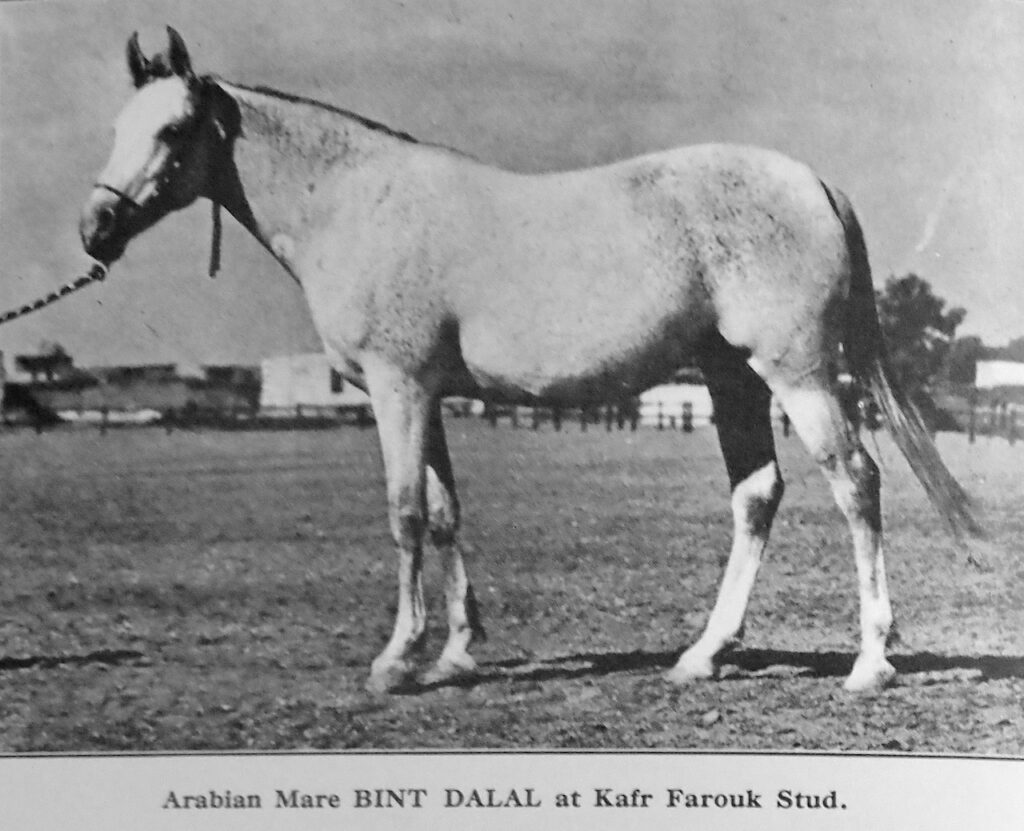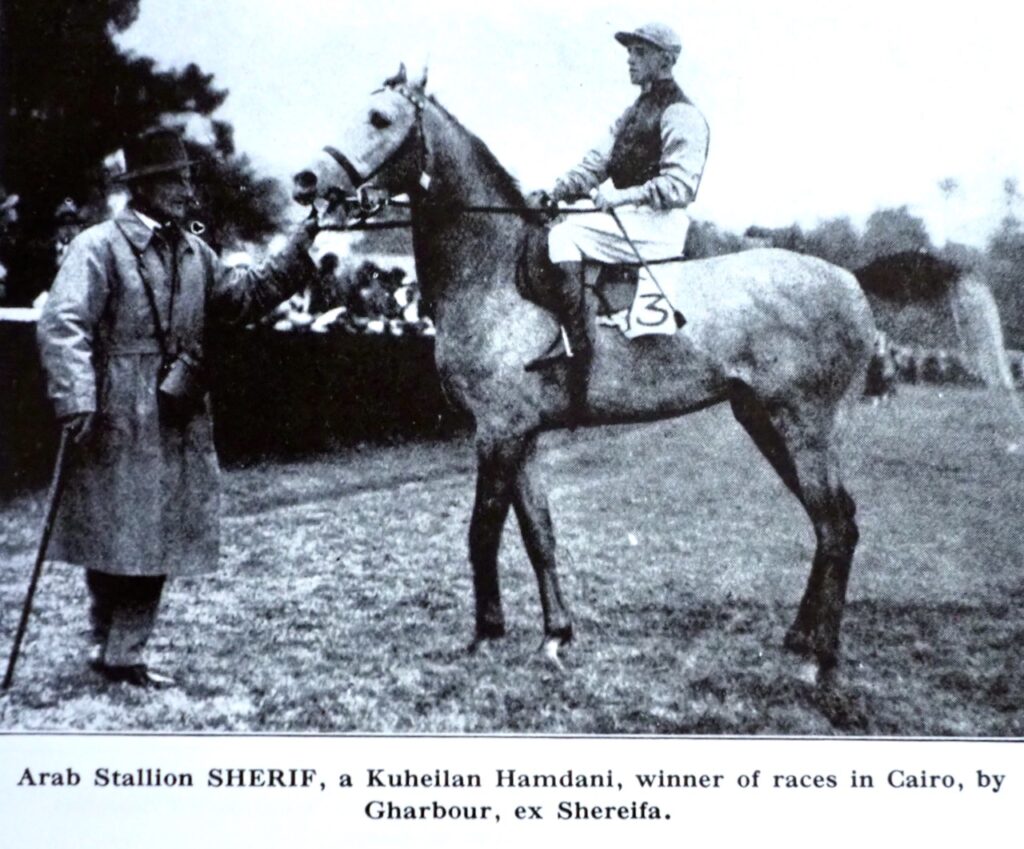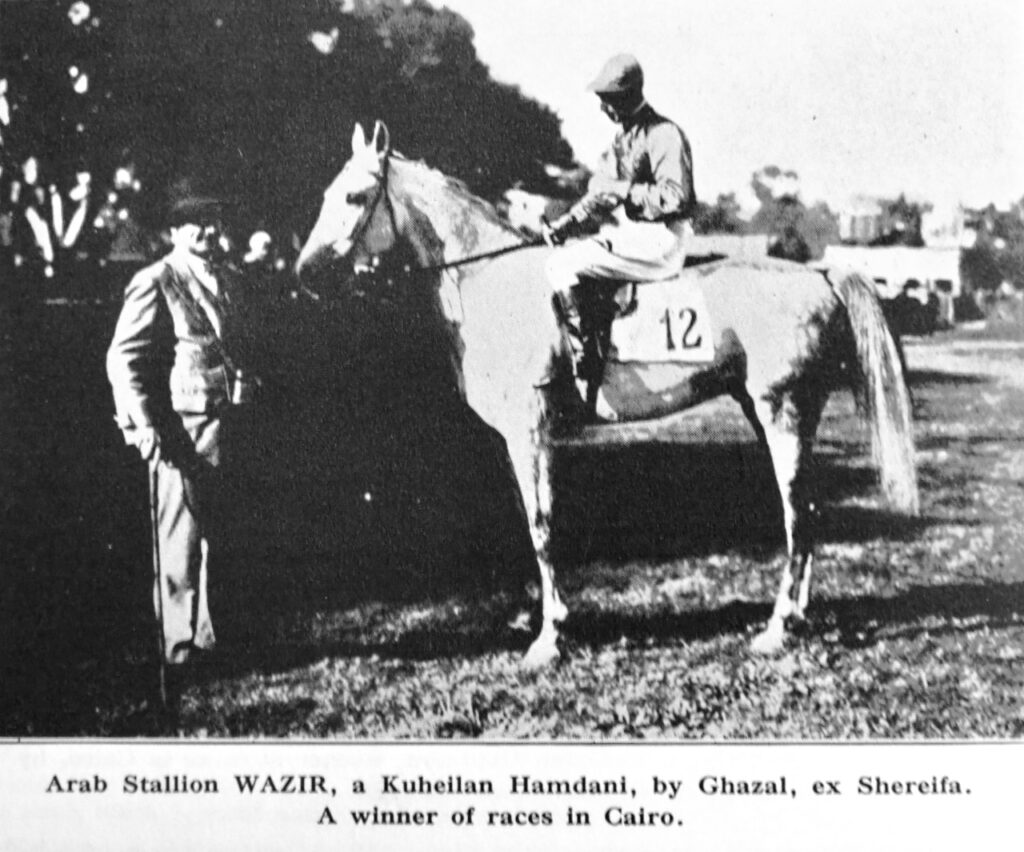Excerpts from “The Arab in Egypt”, from the 1937 Journal of the Arab Horse Society
The article was written by Fouad Abaza, the Director-General of the Royal Agricultural Society of Egypt and a Governor of the Arab Horse Society of England. It includes a description by Doris Walter of her 1934 visit to Kafr Farouk, as well as a description of T.G.B. Trouncer’s Sidi Salem stud.
There are a few studs of pure-bred Arabs, of which we may mention those of:—
His Royal Majesty the King.
The Royal Agricultural Society.
H. E. Mahmoud Attribi Pasha.
Said Bey Samaha.
Mr. Trouncer.
Daira Lotfallah Pasha.
Some members of the the El Tahaoui family in the Sharkia Province, and a few other individuals, also own mares obtained from the above-mentioned studs.
The mares in the first five studs are nearly all the descendants of Abbas Pasha I famous horses, and all these studs maintain their own stallions.
Nearly all the other breeders all over the country depend entirely on the Royal Agricultural Society’s stallions, which are distributed in twenty-five districts in Egypt.
p. 103
The stallions were distributed as follows (p. 107):
- Gharbia Province, Tanta District: IBN AROUSSA, IBN YASHMAK
- Gharbia Province, Sakha District: SAMEH
- Behera Province, Abou Homos District: AWAD, ARIS
- Menoufia Province, Shebin el Kom District: IBN BINT RABDAN
- Sharkia Province, Zagazig District: ROI HERODE, GHAZWAN
- Dakahlia Province, Simbellawein District: KHAMSIN
- Guiza Province, Saff District: IBN GHAZAL, HELAL
- Fayoum Province, Fayoum District: MABROUK, IBN BINT RISKALLA
- Beni Souef Province, Wasta District: IBN SABAH
- Beni Souef Province, Beni Souef District: HADBAN, TAALAB
- Beni Souef Province, Beba District: GAMIL
- Minia Province, Fashn District: KHEIR
- Minia Province, Maghagha District: KHATER
- Minia Province, Beni Mazar District: BAYYAD
- Minia Province, Samalout District: IBN HAMRAN
- Minia Province, Minia District: HERON (Thoroughbred), COMMANDANT
- Minia Province, Abou Karkas District: NABIL
- Assiout Province, Mallaoui District: RASSEM
- Assiout Province, Assiout District: KAROUN, COOKIE’S BROTHER (Thoroughbred)
- Assiout Province, Manalout District: EBEYAN
- Guerga Province, Sohag District: BARAKAT
- RAS Guezireh stud: FAYED, RADI, BALANCE, KAZMEYN, IBN RUSTEM, GAZLAN
- RAS Bahtim stud: IBN MANIAL, IBN DURA, RABEH, IBN RADIA
- RAS Kafr Farouk stud: IBN RABDAN, MANSOUR, IBN SAMHAN DAREH
Doris Walter records her impressions of some of the horses at Kafr Farouk:
Prominent among the mares in the paddocks was FARIDA, mother of BALANCE, and all those malicious tongues which wagged and said that BALANCE was a country-bred need only look at FARIDA, and then see the sire, to realise that all they said was, as the Americans would say, all hooey.
p. 108
Wending our way back we paid a prolonged visit to the stables of the mares, 30 in number, and one and all came in for admiration. FARIDA made a splendid subject for photography, but IBN BINT SABHA [sic] was a little troublesome and required no little patience. BINT BALAL [sic], a lightish dapple grey, who was certainly not left behind when good looks were being handed out, also made a fine figure.
p. 109

The average of breeding at Kafr Farouk is about 20 foals yearly, and of those over 70 per cent. prove successful either as stallions or mares. Never before have they managed to obtain such a magnificent specimen of the Arab as BALANCE, and the Committee are already studying ways and means whereby it may be possible to produce others of his type. IBN RABDAN has been responsible for some good ponies and horses, but they have fallen far short of the standard set by BALANCE. Two of IBN RABDAN’s stock on the racecourses at present are REALL and RABDAN. The sire is over 18 years old and has been at stud for 12 years, but is still very fertile.
p. 109
The Sidi Salem section of the article may also have been written by Doris Walter, rather than Fouad Abaza.
The first acquaintance I made was the 19-year-old mare called HEGAZIEH, broad of girth and of beautiful proportions, her head being typical of the type so often heard of, but rarely seen out of its native haunts, Koheilet El Ayala, in the Nejd country. Interesting history is attached to this mare, who was originally the property of King Hussein. This monarch, it may be remembered, abdicated in favour of his son, Emir Aly, and went to Cyprus, taking with him two mares and two stallions. An unfortunate episode there, however, resulted in one of the mares and one stallion being killed, while the two remaining were sold, the mare eventually finding her way into the Sidi Salem Stud. Since covered by IBN REDBAN [sic], a stallion belonging to the Royal Agricultural Society of Egypt, this mare produced a colt who, as a yearling, shows signs of becoming an excellent specimen of his race. HEGAZIEH is now in foal to GHARBOUR, another of the same Society’s stallions.
p. 111
Edouard has already related the story of Sharif Hussein’s other mare in a previous post. Hegazieh’s yearling colt by Ibn Rabdan was Talal.
I was then shown what is considered to be the finest young Arabian mare in Egypt, RASALLA, a delightful six-year-old bay. This is one of those purchased from the late Prince Kemal El Dine’s Stud at Saft, and is by RUSTEM, who was imported from Lady Wentworth’s Crabbet Arabian Stud, and is out of SIT SERRA, a Seglawieh Jedranieh of Ibn Sudan strain of the Roala tribe, which makes RASALLA a most valuable acquisition.
The 17-year-old mare named SIT SERRA was then brought out for my inspection. Bred by the late Lady Anne Blunt at her ‘Sheikh Obeid’ Stud, SIT SERRA was renowned as being one of the best mares in the Land of the Pharoahs [sic], and passed into the possession of the late Prince Kemal El Dine, from whom Mr. Trouncer was fortunate to purchase her. SIT SERRA has since been covered by the champion, IRAM, an Egyptian Government stallion imported from Lady Wentworth’s Stud.
I then saw a graceful grey four-year-old daughter of SIT SERRA, by RUSTEM, and therefore a full sister to RASALLA, whom she greatly resembles in conformation and general characteristics.
p. 111f.
The Iram to whom Trouncer had bred Sit Serra may have been the 1923 Skowronek son.

The last of the older generation was another grey 12-year-old mare, SHEREIFA, whom I was given to understand is a great favourite with all connected with the stable, being everything that may be considered gentle and docile, albeit exhibiting all the qualities of an excellent brood mare. SHEREIFA was accompanied by a prancing two-months-old colt, as full of fun and frolic as his dam was docile.
The younger generation now growing up in the ideal surroundings provided for them by the capable hands of Mr. Trouncer, should be of undoubted satisfaction to this genial breeder, as SHERIF, who then came to my notice, a full brother to the colt just mentioned, and whom I omitted to say was by GHARBOUR, has already earned fame by securing 1st prize in a two-year-old class at the Ministry of Agriculture’s Horse Show, held at Tanta, on the 29th April, 1932, when he was adjudged the “Champion of the Show.”
I was also shown some other youngsters who should soon follow in SHERIF’s footsteps, two of which are out of the afore-mentioned SHEREIFA. The first was a yearling colt named WAZIR, whose sire is GAZELLE, and the second a nice two-year-old brown filly called EMIRA, by KAZMEEN, both sires being from the Royal Agricultural Society’s Stud.
p. 112
Shereifa was a Hamdaniyah. Both Sherif and Wazir went on to be winning racehorses in Cairo.

ALL OF THE HORSES PICTURED HAVE FABULOUS COUPLINGS! If only our horses nowadays were built like those pictured!
best
Bruce Peek
They are nice horses, even if Bint Dalal looks a little plump.
Just to say that for a long time, the bottom photo, was mistakenly believed to have depicted Wazir (Zobeyni x Ghazieh) born in 1863. Glad that you clarified who the alternative Wazir was.
I had not a clue! I presume the man on the ground is Trouncer and that he had been cropped out of the picture, for people to believe it was a nineteenth century horse. Pretty sure Muybridge pioneered high speed photography in the 1870s as well, and that cameras weren’t quick enough and/or emulsions not good enough to capture a potentially fidgety racehorse in the mid-1860s.